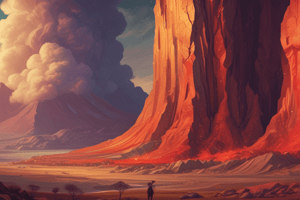Podcast
Questions and Answers
What type of plate boundary occurs when two plates move away from each other, allowing magma to rise and solidify on the sea floor?
What type of plate boundary occurs when two plates move away from each other, allowing magma to rise and solidify on the sea floor?
- Transform boundary
- Divergent boundary (correct)
- Convergent boundary
- Strike-slip boundary
Which type of plate boundary forms underwater volcanic chains known as island arcs?
Which type of plate boundary forms underwater volcanic chains known as island arcs?
- Triple junction
- Convergent boundary (correct)
- Divergent boundary
- Transform boundary
What geological phenomenon is associated with transform plate boundaries?
What geological phenomenon is associated with transform plate boundaries?
- Magma solidification on the sea floor
- Volcanic mountain ranges creation
- Mid-ocean ridges formation
- Horizontal grinding of plates causing earthquakes (correct)
At what type of plate boundary does subduction occur, leading to the creation of volcanic mountain ranges near coastlines?
At what type of plate boundary does subduction occur, leading to the creation of volcanic mountain ranges near coastlines?
Which type of plate boundary involves plates sliding past each other horizontally?
Which type of plate boundary involves plates sliding past each other horizontally?
What is the main process associated with divergent plate boundaries that leads to the formation of new oceanic crust?
What is the main process associated with divergent plate boundaries that leads to the formation of new oceanic crust?
What type of plate boundary is the Dead Sea Transform an example of?
What type of plate boundary is the Dead Sea Transform an example of?
Which natural phenomenon is primarily responsible for the formation of volcanoes along plate boundaries?
Which natural phenomenon is primarily responsible for the formation of volcanoes along plate boundaries?
What causes most earthquakes to occur at plate boundaries?
What causes most earthquakes to occur at plate boundaries?
Which supercontinent is believed to have existed before the continents drifted apart?
Which supercontinent is believed to have existed before the continents drifted apart?
Which layer of Earth is located between the outer core and the exosphere?
Which layer of Earth is located between the outer core and the exosphere?
What is the outermost layer of the Earth called?
What is the outermost layer of the Earth called?
Flashcards are hidden until you start studying
Study Notes
Plate tectonics is the scientific theory explaining the movement of Earth's lithosphere and its interaction with the asthenosphere. This process involves several key features including tectonic plates, plate boundaries, volcanoes, earthquakes, and continental drift.
Tectonic Plates
Tectonic plates are large pieces of Earth's rigid outer layer called the lithosphere. They make up the surface of the planet, dividing it into several major sections known as continents and oceans. These plates float on a molten magma ocean beneath known as the mantle. There are seven main types of these plates, which can be classified based on their composition: the Eurasian, North American, African, Antarctic, Indo-Australian, Pacific, and South American.
Plate Boundaries
The edges where two tectonic plates meet are called plate boundaries. There are three main types of plate boundaries: convergent, divergent, and transform. Convergent boundaries occur when two plates collide, leading to either subduction zones—where one plate disappears beneath another—or collision zones, forming mountain ranges. Divergent boundaries appear when plates move away from each other, creating new crust along the rift valleys. Transform boundaries form when plates slide past one another, causing fault lines and seismic activity.
Volcanoes and Earthquakes
Volcanic eruptions and earthquakes are common phenomena associated with plate tectonics. When tectonic plates are pushed together due to convergence, stress builds between them until they break apart and release energy through an earthquake. Similarly, magma released during the separation of plates contributes to the formation of volcanic structures such as islands, mountains, and even the entire continents themselves.
Continental Drift
Continental drift refers to the idea that the continents have shifted positions throughout geological time, driven by the movements of the underlying tectonic plates. This phenomenon was first proposed by Alfred Wegener in 1912 who suggested that Pangaea, a supercontinent, existed around 200 million years ago and broke apart over millions of years, giving rise to today's landmasses.
Studying That Suits You
Use AI to generate personalized quizzes and flashcards to suit your learning preferences.



